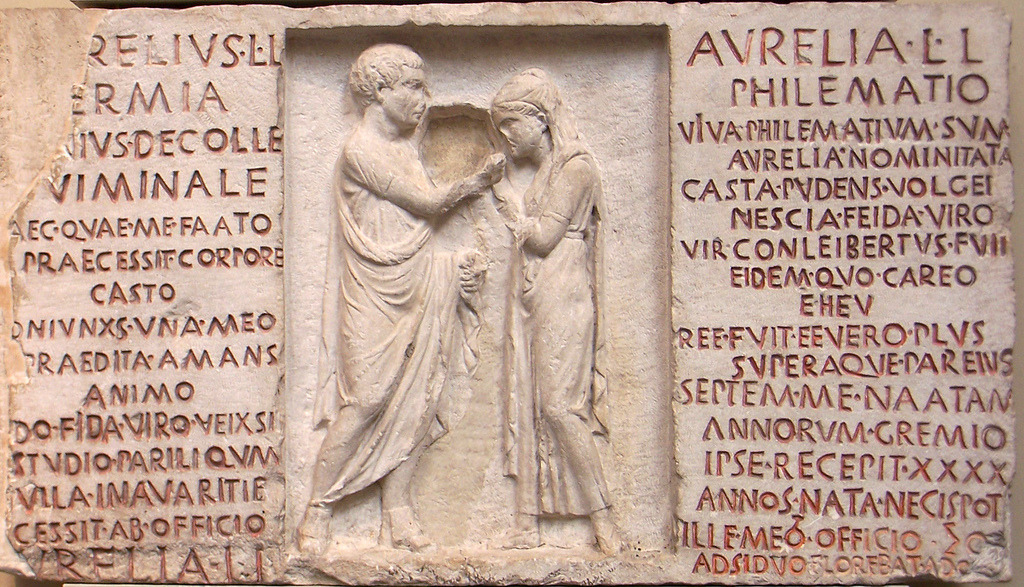apuleiaprimilla:The aspects of face and dress of the man on this funerary stele date it to the last
apuleiaprimilla:The aspects of face and dress of the man on this funerary stele date it to the last century of the Roman Republic. The woman’s head and veil have been restored. She raises her husband’s right hand to her lips in a gesture of farewell, indicating that she has predeceased her spouse.It reads: L. Au]relius L[uci] l[ibertus] [H]ermia [la]nius de colle Viminaleh]aec quae me faato praecessit corpore castoc]oniunxs una meo praedita amans animofi]do fida viro veixsi[t] studio parili qumnulla in avaritie cessit ab officio.Au]relia L. l.Aurelia L[uci] l[iberta]Philematioviva Philematium sumAurelia nominitatacasta pudens volgeinescia feida virovir conleibertus fuiteidem quo careoeheuree fuit ee vero plussuperaque parensseptem me naatamannorum gremioipse recepit XXXXannos nata necis pot[ior]ille meo officioadsiduo florebat ad o[mnis].It translates: Aurelius Hermia, freedman of Lucius, butcher of the Viminal hill. This woman, who has preceded me in death, chaste of body, loving of spirit, my only wife, lived faithful to her faithful husband with equal devotion since she failed in her duty out of no avarice. Aurelia Freedwoman of Lucius.Aurelia Philematio, Freedwoman of Lucius. While I lived, I was named Aurelia Philematium, chaste, modest, ignorant of the rabble, faithful to my husband. My husband, whom I am without, alas, was freedman to this same Lucius. He was to me in fact and in truth more than and beyond a parent. He took me to his bosom at the age of seven years. At the age of forty years I am stronger than death. He flourished in the eyes of all due to my constant dutifulness.The spouses in the inscription were freedpersons of the same patron, whose name was Lucius Aurelius. When slaves were freed in ancient Rome they usually took some form of their patron’s name as their own, hence Aurelius and Aurelia. Their former slave names, which indicate perhaps a Greek origin, are in this instance used as cognomina or last names. The dress and posture of both indicate their new status as Roman citizens. The inscriptions praise especially the qualities of the wife, qualities which conformed with those traits generally admired by the Roman upper classes: dutifulness and faithfulness, chastity and virtue. The man’s character is not so clearly defined—he has acted apparently as more than a husband, in fact, as more than a parent. This reference likely refers to Aurelia having been placed under the protection of the obviously older man while both were still slaves, since as slaves they could come to no legally binding relationship. Manumission would make their marriage possible and legal.80 B.C.; found on the Via Nomentana, Rome© The Trustees of the British Museum, London -- source link
Tumblr Blog : apuleiaprimilla.tumblr.com
#funerary#stele#roman#ancient#relief
